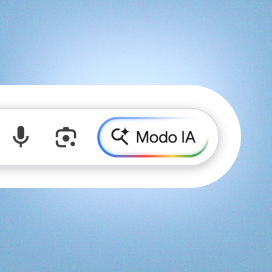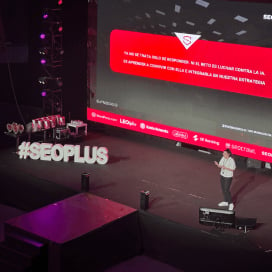Written by Fani Sánchez
Trying to position the different international versions of a website can prove daunting when you target complex combinations of contents, currencies, countries and languages. Sometimes there are just no “obvious” options, and different aspects must be considered to make the right decisions to compete at the international arena.
In this presentation for The Inbounder 2017, Fernando Maciá delivers a step-by-step guide to elaborating a complete SEO strategy for international websites, but in more complex than usual scenarios. He’s going to deal with the implementation of the hreflang tag created by Google, the technical configuration of Search Console to help projecting a correct geographic orientation for search engines, an effective way of structuring the website architecture by country or language, the issue of the root domain in a complex and international architecture, in addition to the linguistic aspects, among others.
If you’ve missed this presentation at The Inbounder, or you would like to refresh the concepts in your mind, here it is! Enjoy!
International SEO in Complex Scenarios from Fernando Maciá Domene
Complex Scenarios in International SEO – Transcript
1. FERNANDO MACIÁ How to Do International SEO in Complex Scenarios
2. I publish…. 2 0 0 0 6 2 0 1 12 0 1 02 0 0 0 9 2 0 1 1 2 0 1 2 2 0 1 2 2 0 1 4 2 0 1 62 0 1 5
3. I teach…
4. I speak at national/international events…
5. I am featured at the media…
6. International SEO: The challenges
7. Understand the motivations & objections of international audience ‣ Adapt to local use of language (even in countries where same language is spoken) ‣ Use international targeting and rel=”alternate”/hreflang Minimize duplicate content risk
8. Even if a user can browse the site from a certain country with multiple languages, focus on indexing and positioning just the one with significant potential Optimize crawl budget
9. Concentrate internal juice flow on your most valuable pages (those with highest PV*conversion*profit values) Optimize link juice
10. Does not matter whether you use ccTLDs, subdomains or subdirectories: ‣ use just one GA UA and analyze traffic from multiple profiles/filters ‣ On multiple domains, use cross domain GA tracking script ‣ Tag the links between ccTLDs to keep session info Make web traffic analysis easier
11. International SEO: The goal
12. Position your best possible content for each international user ‣ Language ‣ Motivations/objections ‣ Currency ‣ Product selection ‣ Logistics… ‣ To get the best CTR/quality of visit/conversion Optimize country &/or language targeting
13. YES. Position the optimal content (language, currency…) Keep certain SE (Baidu, Yandex, etc.) from indexing (via robots.txt) Decision diagram for international SEO targeting 13 STOP YES. Position the default content for the rest of the users YES. Position content in other popular 2nd languages YES. Position content in the right language YES YES YES YES YES YES YES NO NO NO NO NO NO © Fernando Maciá Do we have a default content for users we are not targeting? Do we have content in a language the user, at least, might understand? Do we have content in the user’s language? Do we have specific content for the user language and location? IP geolocation/OS language/cookieVISIT
14. So… Which landing track will your user find?
15. On users’ side….
16. Search user geolocation ‣ With over 75% of searches coming from mobile, user geolocation, search history and “local” search intent will affect the SERPs.
17. User’s Google preferences ‣ With over 75% of searches coming from mobile, user geolocation, search history and “local” search intent will affect the SERPs.
18. Google.cctld Italy Japan Deutschland España Suisse Italy UK used ‣ Google local domain or using different SE (Baidu, Seznam, Yandex…)
19. On our side…
20. hreflang configuration ‣ Useful as a suggestion of language or language/country alternative content for a URL
21. Useful when used coherently associated to rel=”alternate/ hreflang” configuration 21 International targeting configuration on GSC.
22. Link profile geolocation 22 ‣ hreflang is a signal, not a directive: boost your geolocation with a coherently geodistributed link profile.
23. Hosting IP geolocation 23 with CDNwithout CDN Hosting IP is relevant Hosting IP is not relevant
Fetch as Googlebot is not reliable 24 ‣ Caution: since 2015, Googlebot may come from non-USA-located IPs, and so…
25. Check server’s customization configuration 25 spain.info on Google’s cache spain.info from Spain IP customization
26. Use Web Sniffer+HMA to check IP/User agent customization 26 Web Sniffer HMA VPN Use HMA VPN to browse from different locations to check for IP customization Add Googlebot’s user- agent strings to check for UA customization
27. User-agent customization using WS+HMA 27 User-agent=Web Sniffer User-agent= Googlebot IP=USA (Dallas, Tx.) IP=USA (Dallas, Tx.) 302 200 URL=http://as.com URL=http://as.com URL=http://as.com
28. From theory to practice: some application scenarios….
29. spain.info ‣ Official Web site of Spain Tourism in TLD ‣ Gradually growing up 38 different versions in 10 languages ‣ Worked on this site from 2005 to 2013 ‣ Remember: – GWT launched in 2006 – HREFLANG was introduced in dec. 2011 – x-default was introduced in april 2013 29
30. Spain.info: institutional content web site 30 home
31. Spain.info: institutional content web site 31 language targeting home
32. Spain.info: institutional content web site 32 language targeting home country/ language targeting
33. Spain.info: institutional content web site 33 language targeting home country targeting, content partially in English country/ language targeting
34. Spain.info: basic configuration 34 Xxxxxx /fr/ hreflang=”fr” France /fr_CH/ hreflang=”fr-CH” Suisse /de_CH/ hreflang=”de-CH” Belgigue /fr_BE/ hreflang=”fr-BE”
35. Spain.info – Home page Dynamic HTML/IP geolocation 35 home Dynamic IP geolocation canonical: http://www.spain.info/es/ canonical: http://www.spain.info/en-US/
36. Spain.info – Home page Dynamic HTML/IP geolocation 36 URL: http://www.spain.info URL: http://www.spain.info Canonicals specify the URL we want indexed as home page for each version
37. Spain.info – Home page Dynamic HTML/IP geolocation 37 hreflang specify the URL we want indexed for each language/ country combination of the home page
38. Spain.info – Home page hreflang configuration 38 URL: http://www.spain.info/en_US/ URL: http://www.spain.info/de_CH/ Use hreflang for language AND country targeting
39. Spain.info – Home page hreflang configuration 39 URL: http://www.spain.info/fr/ URL: http://www.spain.info/es/ Caution: hreflang cannot be used for country targeting-only Use hreflang for language-only targeting
40. Spain.info – international targeting for each subdirectory from Google Search Console 40 URL: http://www.spain.info/de_CH/ Configure International Targeting on GSC to target the right country URL: http://www.spain.info/en_US/
41. Spain.info – international targeting for each subdirectory from Google Search Console 41 URL: http://www.spain.info/fr/ URL: http://www.spain.info/es/ Don’t configure International Targeting on GSC for language targeting
42. A coherent hreflang configuration and international targeting on GSC yields the most predictable results 42 If your are not targeting a country, leave this blank AND don’t include the country code in hreflang/alternate URL: http://www.spain.info/en/
43. A coherent hreflang configuration and international targeting on GSC yields the most predictable results 43 AND DO include the country code in hreflang/ alternate URL: http://www.spain.info/en_IE/ If you are targeting a country, configure international targeting.
44. Suisse Results: Spain.info on the SERPs 44 Google indexes the right page for the right Google.cctld/user location/user language preferences
45. Results: Spain.info on the SERPs 45 France Google indexes the right page for the right Google.cctld/user location/user language preferences
46. Results: Spain.info on the SERPs 46 UK Google indexes not always positions the right page for the right Google.cctld/user location/user language preferences
47. rel=alternate/hreflang is a signal, not a directive 47. rel=alternate/hreflang is a signal, not a directive 47.
48. Spain.info after hreflang implementation 48 Before After /de_DE/ /de/
49. Spain.info after hreflang implementation 49 Before After After /fr_FR/ /fr/
50. Spain.info after hreflang implementation 50 Before After /en_CA/ /en/
51. 51 ‣ Some common mistakes….
52. Some common mistakes… 52 Using Wikipedia as a “reliable” source for hreflang configuration.
rel=alternate/hreflang should always point to canonical URLs 53.
54. hreflang MUST point to canonical URLs and do not mix canonicals with hreflang and mobile alts 54 URL: http://www.domain.com/es/ URL: http://m.domain.com/es/ These are wrong because they point to non-canonical URLs
55. URL: http://m.domain.com/es/ hreflang MUST point to canonical URLs 55 URL: http://www.domain.com/es/ This is the only rel=”alternate” needed to reference the mobile URL (but no hreflang).
56. x-default MUST point to IP redirecting or lang selection pages 56 x-default is for IP redirecting or language selection pages
57. Summing up (home page)… 57 http://www.domain.tld/es/ Include rel=”canonical” Include hreflang to itself Include hreflang to rest of language-targeted versions Include hreflang to rest of country-targeted versions Include rel=”alternate” to mobile version Include hreflang to rest of country-targeted versions Include rel=”canonical” to desktop version This is the only rel=”canonical” needed to reference the desktop URL from the mobile version (but no hreflang!) Use x-default to signal a default landing home page (not on every page)
58. Summing up (home page)… 58 http://www.domain.tld/es/ Include rel=”canonical” Include hreflang to itself Include hreflang to rest of language-targeted versions Include hreflang to rest of country versions Include rel=”alternate” to mobile version Include hreflang to rest of country-targeted versions Include rel=”canonical” to desktop version This is the only rel=”canonical” needed to reference the desktop URL from the mobile version (but no hreflang!) Use x-default to signal a default landing home page (not on every page)
59. Summing up (internal pages)… 59 http://www.domain.tld/es/colores.html Include rel=”canonical” Include hreflang to itself Include hreflang to rest of language-targeted versions Include hreflang to rest of country-targeted versions Include rel=”alternate” to mobile version Include rel=”canonical” to desktop version This is the only rel=”canonical” needed to reference the desktop URL from the mobile version (but no hreflang!)
60. Key take-aways 60 ‣ International versions on TLD subdirectories generally yield best results ‣ x-default must point to IP redirecting or language selection pages only ‣ If you have country/language targeted subdirectories, you should also have language-only targeted subdirectories (not country targeted) as a default for not-geolocated users ‣ Do not mix rel=”alternate” link elements for mobile content with rel=”alternate/hreflang” for international targeting ‣ Beware: hreflang is just a signal. Give your country-targeted versions a boost with a properly geodistributed link profile, IA jerarchy AND content localization
61. 61 And… what problem is there with the home page?
62. 62 Pre-home page with a language/country selector
63. Pros: configuration of product portfolio, currency, prices, applicable taxes, shipping options… 63 https://www.zara.com/es/https://www.zara.com/
64. Pros: the user’s next visits to our website will direct them to the correct version 64 https://www.zara.com/es/https://www.zara.com/ https://www.zara.com/
65. Pros: equal distribution of popularity juice between the many different home versions 65.
66. Cons: we are somehow wasting our most powerful URL address’ strength 66
67. Cons: it adds an extra click for users visiting our page for the first time 67 https://www.zara.com/es/https://www.zara.com/
68. Cons: cookie-dependent navigation may cause indexability problems 68 https://www.zara.com/es/https://www.zara.com/ https://www.zara.com/ Be careful if you make navigation dependent on the value of a cookie. Googlebot does NOT accept cookies.
69. When is it recommended to use this option? 69 ‣ When our audience is very fragmented between many different countries and there isn’t a country that concentrates a significantly greater share of our demand. ‣ When language and country variables are crucial for the personalisation of the offer: available product families, currency, prices, prices, shipping options, applicable taxes, etc. ‣ When brand awareness among users reduces the usual organic traffic proportion, and the dependence upon good rankings for generic search queries is inferior. ‣ When the domain authority is high, so that even if our root domain’s popularity juice is distributed into multiple subdirectories, the brand still holds an advantage over its competitors.
70. Which aspects should we take into consideration? 70 ‣ We should set the “default” content that search engines can crawl in the absence of cookies and session variables. ‣ We must keep in consideration the effect of the personalisation settings the server could input, based on the IP address of origin or the user-agent of the browser. It shouldn’t get in the way of the search engine bots. ‣ We must configure the alternate/hreflang link element in the different versions of the home page (only there), pointing to the root domain with an “x-default” option (besides the corresponding alternate/hreflangs to the home pages of all versions). ‣ We must include alternate/hreflang link elements at the root domain, pointing to the home page of each version, besides the self-referential alternate/hreflang link.
71. 71 Home page with a preferred language or language/country by default
72. Pros: our most profitable market on our strongest URL 72
73. Pros: shortens the click distance for our most valuable clients 73 http://www.apple.com/iphone-7/http://www.apple.com/
74. Pros: no cookies needed means fewer problems for SE crawlers 74 http://www.apple.com/
75. Cons: depending on the default language, it can be challenging to select the right version 75 For some users, it might not be obvious where the version selector is
76. Cons: it is easy for users to compare prices for the same item between versions 76
77. When is it recommended to use this option? 77 ‣ When one of the markets we cater to concentrates a large share of the total demand, so it is worth prioritizing the positioning of one particular version over all the available ones. ‣ When we want to corporately identify a website with one country in particular, such as the place of origin of a company or the national ownership of an institution.
78. Which aspects should we take into consideration? 78 ‣ There are no problems when it comes to crawlability of the website in the absence of cookies or session variables. ‣ It is not recommended to configure any alternate/ hreflang link elements with the “x-default” option of default content. However, we could provide default content directories in every language, to which we can direct users whose countries don’t have a specific version.
79. 79 Personalised content (IP, OS/UA language preferences…) http://www.spain.info/
80. Pros: better user experience 80 http://www.spain.info/
81. Cons: difficult to control how search engines will crawl the website 81 cache:http://www.spain.info/
82. Cons: when including dynamic canonicals, the root domain might not get indexed 82.
83. Cons: risk of duplicate content getting indexed 83 http://www.spain.info/en_US/ http://www.spain.info/
84. When is it recommended to use this option? 84 ‣ When our top priority is user experience and the website is supported by other means of traffic generation, making the weight of organic search traffic over the total traffic only relative. ‣ If we choose to implement dynamic canonical link elements, the root domain URL won’t be indexed, and the behavior in this case will be exactly as described in the next scenario.
85. Which aspects should we take into consideration? 85 ‣ Check the content that the server will display by default when it can’t find the required variables to personalise the content, as this is what Google will see ‣ Possible case of content indexed in several languages under the same URL (as a result of several visits by Googlebot from IP addresses geolocated in different countries) ‣ Recommended to include a dynamic canonical link element pointing to the canonical URL corresponding to each different case
86. Non-indexable URL on the root domain (IP/UA redirecting home page) 86.
87. Non-indexable URL on the root domain (IP/UA redirecting home page) 87.
88. Pros: better user experience 88 https://www.tous.com/ https://www.tous.com/us-en/ https://www.tous.com/fr/ https://www.tous.com/es-es/
89. Cons: the root domain will not get indexed so we somehow lose the most authorative URL 89
90. When is it recommended to use this option? 90 ‣ When we don’t want to prioritize a specific version over the rest.
91. Please note 91 ‣ If we personalise redirections on the home page to redirect users towards the subdirectory corresponding to their IP and/or language, then these redirections should be 301. ‣ Alternatively, and if we wanted any of these versions to be identified as the default version, this redirection (and just this one) could be 302. In that case, the canonical link element of the home page of this subdirectory and corresponding links should point to the root domain.
92. Wrapping up… 92 ‣ Some times, there is just not an “obvious” best international SEO implementation. ‣ When testing all these server-side behaviours, tools like HMA! VPN and HTTP Sniffer come in very handy, as they enable us to check server personalisation configuration based on: ‣ IP ‣ OS/UA language preferences ‣ User-Agent ‣ Analyse each possible scenario, the aspects we should prioritize in every case, and consider the demands of our technological infrastructure, in order to choose the most appropriate option for our home page ‣ Boost your international targeting with geolocated popularity profile ‣ Check the SERPs to confirm whether Google is understanding your implementation.
93.
94. Fernando Maciá Domene CEO Human Level Communications



